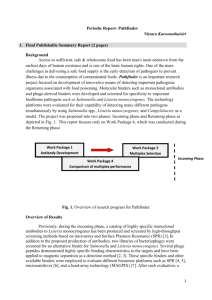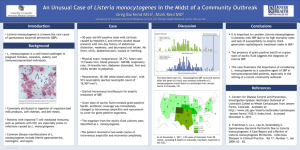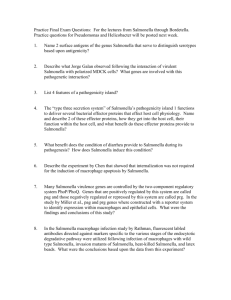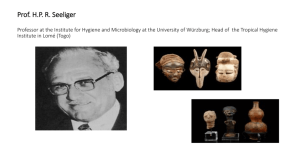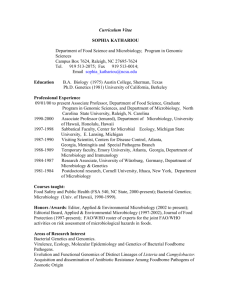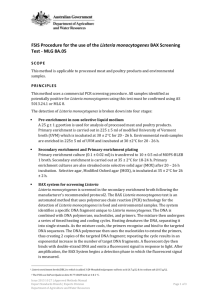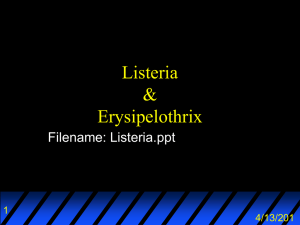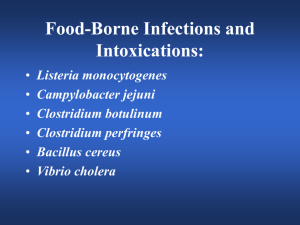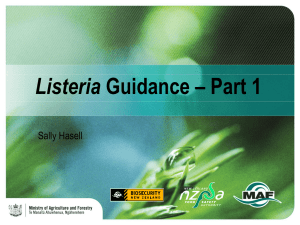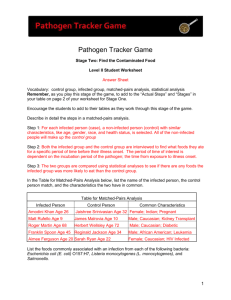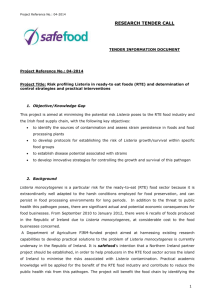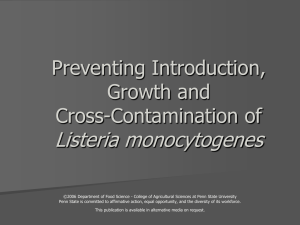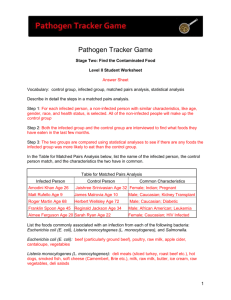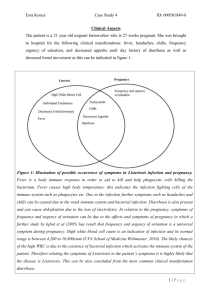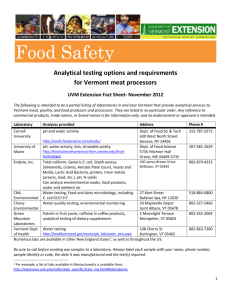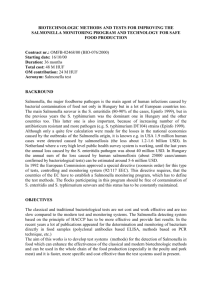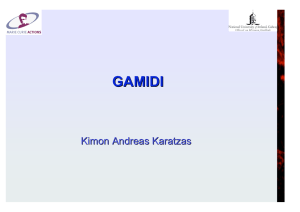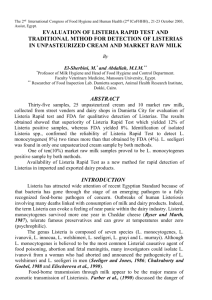final1-final-report-phase-ii-final
advertisement
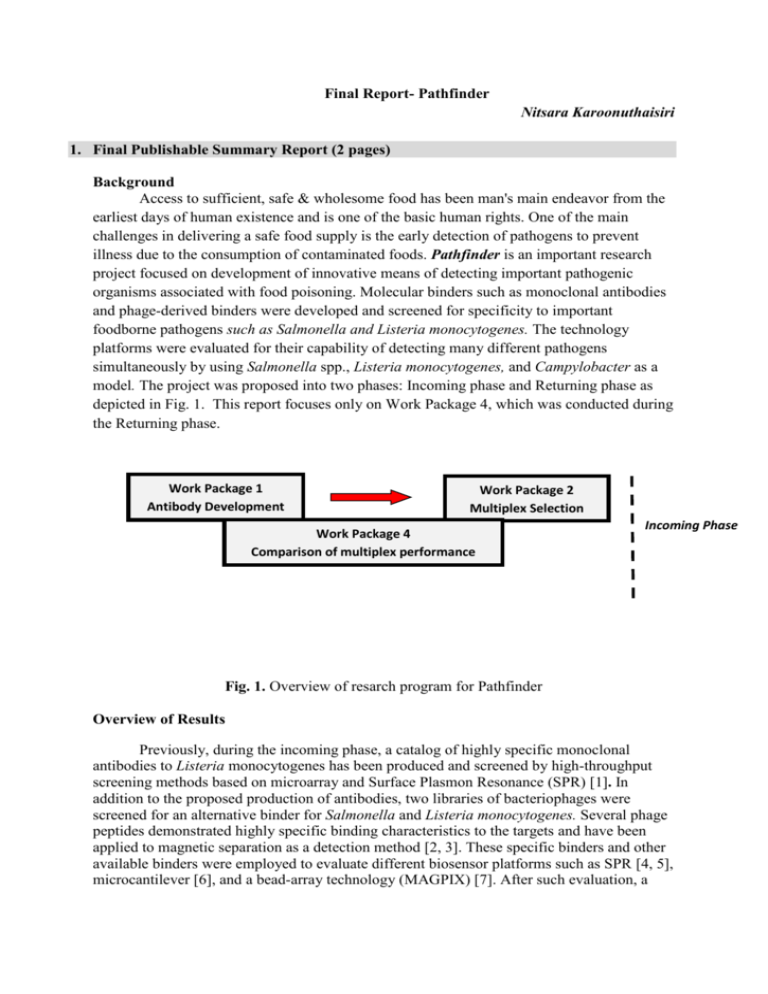
Final Report- Pathfinder Nitsara Karoonuthaisiri 1. Final Publishable Summary Report (2 pages) Background Access to sufficient, safe & wholesome food has been man's main endeavor from the earliest days of human existence and is one of the basic human rights. One of the main challenges in delivering a safe food supply is the early detection of pathogens to prevent illness due to the consumption of contaminated foods. Pathfinder is an important research project focused on development of innovative means of detecting important pathogenic organisms associated with food poisoning. Molecular binders such as monoclonal antibodies and phage-derived binders were developed and screened for specificity to important foodborne pathogens such as Salmonella and Listeria monocytogenes. The technology platforms were evaluated for their capability of detecting many different pathogens simultaneously by using Salmonella spp., Listeria monocytogenes, and Campylobacter as a model. The project was proposed into two phases: Incoming phase and Returning phase as depicted in Fig. 1. This report focuses only on Work Package 4, which was conducted during the Returning phase. Work Package 1 Antibody Development Work Package 2 Multiplex Selection Work Package 4 Comparison of multiplex performance Incoming Phase Fig. 1. Overview of resarch program for Pathfinder Overview of Results Previously, during the incoming phase, a catalog of highly specific monoclonal antibodies to Listeria monocytogenes has been produced and screened by high-throughput screening methods based on microarray and Surface Plasmon Resonance (SPR) [1]. In addition to the proposed production of antibodies, two libraries of bacteriophages were screened for an alternative binder for Salmonella and Listeria monocytogenes. Several phage peptides demonstrated highly specific binding characteristics to the targets and have been applied to magnetic separation as a detection method [2, 3]. These specific binders and other available binders were employed to evaluate different biosensor platforms such as SPR [4, 5], microcantilever [6], and a bead-array technology (MAGPIX) [7]. After such evaluation, a bead-array technology was the most appropriate method due to its multiplex capacity and sensitivity which were better than the standard ELISA method. During the returning phase, the bead-array technology was used to perform multiplex detection of Salmonella spp., Listeria monocytogenes, and Campylobacter spp. in actual food samples (roasted chicken barbecue with honey, grilled black pepper chicken, and raw chicken marinated in sesame sauce) [8]. To simulate foodborne pathogens contamination, each pathogen was inoculated into the food samples at 0, 1, and 10 colony forming unit (CFU). The samples were subsequently cultured according to the international organization for standardization (ISO 10272, 11290, and 6579 for Campylobacter spp., Listeria monocytogenes, and Salmonella spp., respectively). Samples from each culture protocol were mixed and tested at 24, 48 and 72 hours by the bead-array method and a conventional plate-count protocol to enumerate the bacteria number. The results showed that the bead-array method was able to detect even at 1 CFU after being cultured for 24 hours in case of Salmonella spp. and 48 hours in case of Listeria monocytogenes and Campylobacter spp. From the plate-count method of the 24-hr culture of Salmonella spp and the 48-hr cultures of Listeria monocytogenes and Campylobacter spp., 6.0- 40.0 x 107 CFU/mL, 5.0-10.0 x 108 CFU/mL and 2.0-6.0 x 108 CFU/mL were found, respectively. Conclusion Pathfinder project has considerably made advancement for the food safety measure by constructing a novel multiplex detection method for foodborne pathogens. Through the process of the development, this project generated several important research milestones. First, different types of binders, monoclonal antibodies and phage-derived peptides, were produced, screened and exploited for their molecular binding capacity. These developed bioreceptors from this project can be further applied to other types of biosensor platforms or other applications beyond imagination. Second, several technology platforms were evaluated. Through these evaluations, multiplex detections for both food and plant pathogens were achieved. The optimization and signal enhancement strategies can also serve as a guideline for similar assay development for these types of biosensors. In addition, the developed bead array method has been demonstrated to be able to detect Campylobacter spp., Listeria monocytogenes, and Salmonella spp. contaminated in various actual food samples using the conventional enrichement methods according to the international organization for standardization. Socio-economic Impacts The research outputs are of direct significance to food producers/processors, food inspectors and regulatory and testing laboratories. A successful validation of the developed multiplex detection based on bead-array technology is to be transferred to food producers. This will provide a rapid, accurate, economical testing method for the food industry to reduce the testing cost while increase the credibility for food safety. Moreover, the ability to prevent bacterial contamination in food chain means betterment for public health. References 1. 2. 3. 4. 5. 6. 7. 8. 2. Charlermroj, R., et al., Comparison of techniques to screen and characterize bacteria-specific hybridomas for high-quality monoclonal antibodies selection. Anal Biochem, 2012. 421(1): p. 26-36. Morton, J., et al., Phage display-derived binders able to distinguish Listeria monocytogenes from other Listeria species. PLoS One, 2013. 8(9): p. e74312. Morton, J., et al., Production and evaluation of the utility of novel phage display-derived peptide ligands to Salmonella spp. for magnetic separation. J Appl Microbiol, 2013. 115(1): p. 271-81. Charlermroj, R., et al., Strategies to improve the surface plasmon resonance-based immmunodetection of bacterial cells. Microchimica Acta, 2013. 180(7-8): p. 643-650. Karoonuthaisiri, N., et al., Development of a M13 bacteriophage-based SPR detection using Salmonella as a case study. Sensors and Actuators B-Chemical, 2014. 190: p. 214-220. Wang, J.H., et al., Rapid Detection of Pathogenic Bacteria and Screening of Phage-Derived Peptides Using Microcantilevers. Analytical Chemistry, 2014. 86(3): p. 1671-1678. Charlermroj, R., et al., Multiplex detection of plant pathogens using a microsphere immunoassay technology. PLoS One, 2013. 8(4): p. e62344. Karoonuthaisiri, N., et al., Bead array for Listeria monocytogenes detection using specific monoclonal antibodies. Food Control, 2015. 47(0): p. 462-471. Use and dissemination Outputs I. Peer-reviewed publications Incoming Phase 1. Karoonuthaisiri, N. Charlermroj, R., Teerapornpuntakit, J., Kumpoosiri, M., Himananto, O., Grant, I.R., Gajanandana, O., Elliott, C.T., Production and characterization of specific Listeria monocytogenes monoclonal antibodies and their applications in two immunochemical platforms. (submitted) 2. Karoonuthaisiri, N. Charlermroj, R., Morton, M.J., Oplatowska, M., Grant, I.R., Elliott, C.T., Development of a M13 Bacteriophage-based SPR detection assay using Salmonella detection as a case study (revised Sens. Actuators B: Chem) 3. Morton, M.J., Karoonuthaisiri, N., Charlermroj, R., Stewart, L.D., Elliott, C.T., Grant, I.R. 2013. Phage display-derived binders able to distinguish Listeria monocytogenes from other Listeria species. Plos One (accepted) 4. Morton, M.J., Karoonuthaisiri, N., Stewart, L.D., Oplatowska, M., Elliott, C.T., Grant, I.R. 2013. Production and evaluation of the utility of novel phage display-derived peptide ligands to Salmonella spp. for magnetic separation. J Appl Microbiol 115: 271—281. doi: 10.1111/jam.12207 5. Charlermroj, R., Oplatowska, M., Gajanandana, O., Himananto, O., Grant, I.R., Karoonuthaisiri, N., Elliott, C.T. 2013. Strategies to Improve the Surface Plasmon Resonance-Based Immmunodetection of Bacterial Cells. Microchimica Acta 180(7): 643-650. doi: 10.1007/s00604-013-0975-x 6. Charlermroj, R., Himananto, O., Seepiban, C., Kumpoosiri, M., Warin, N., Oplatowska, M., Gajanandana, O., Grant, I.R., Karoonuthaisiri, N., Elliott, C.T. 2013. Multiplex Detection of Plant Pathogens Using a Microsphere Immunoassay Technology. PloS ONE 8(4):e62344. doi:10.1371/journal.pone.0062344 7. Charlermroj, R., Oplatowska, M., Kumpoosiri, M., Himananto, O., Gajanandana, O., Elliott, C., Karoonuthaisiri, N.* 2012. Comparison of techniques to screen and characterize bacteria-specific hybridomas for high quality monoclonal antibodies selection. Analytical Biochemistry 421(1):2636. doi: 10.1016/j.ab.2011.10.005 Returning Phase 8. Wang, J., Morton, M., Elliott, C., Karoonuthaisiri, N., Segatori, L., Biswal, S. L. 2014. Rapid detection of pathogenic bacteria and screening of phagederived peptides using microcantilevers. Anal Chem. 86 (3): 1671–1678 9. Karoonuthaisiri, N.*, Charlermroj, R., Teerapornpuntakit, J., Kumpoosiri, M., Himananto, O., Grant, I.R., Gajanandana, O., Elliott, C.T. Bead array for Listeria monocytogenes detection using specific monoclonal antibodies. Food Control 47 (2015) 462-471 II. Workshop, seminar and conferences Phase Incoming Date 29-30 September 2011 12 March 2012 13 March 2012 24 February 2012 1-2 May 2012 12-13 June 2012 19 June 2012 18-19 June 2013 Name Microarray World Congress Location San Francisco, USA Responsibility Speaker FP7/FP8 People Programme Workshop FP7 Cooperation-Food and Environment Info Day How to write an FP7 Marie Curie Proposal Safefood Microbial Networks Conference Immunomagnetic bead array training (Luminex Training) BIOTEC, Thailand BIOTEC, Thailand Organizer, Speaker Organizer, Speaker Queen’s University, UK Belfast, UK Speaker Institute for Global Food Security, Queen’s University, UK Bonn, Germany Organizer Institute for Global Food Security, Queen’s University, UK Organizer Challenges and opportunities of International Cooperation in Horizon 2020 Microarray fabrication using Piezoeletric microarray spotter (Scienion Training) Speaker Speaker 1-2 Aug 2013 Cartridge assembly for a multiplexed fluorescence immunoassay system (MBio Array Training) Institute for Global Food Security, Queen’s University, UK Returning 22 Oct 2013 Risk assessment and food National Science safety in chicken and Technology industry: farm to fork. Development Agency 11-13 Dec ASEAN+ 2013 The 2nd Chiang Rai, 2013 Regional Symposium on Thailand Biosensors, Biodiagnostics and Biochips 2-3 Apr The 4th International Bangkok, 2014 Biochemistry and Thailand Molecular Biology Conference. 21-23 May International Conference Bangkok, 2014 on Discrete Mathematics Thailand and Applied Sciences 29-30 Sep International BioScience Phuket Thailand 2014 Conference III. PhD Students Mr. Ratthaphol Charlermroj, graduated with PhD on 1 July 2013 Mrs. Mary Josephine Morton, graduated with PhD in Winter 2013 Organizer and trainer Speaker Keynote speaker Invited Speaker Invited Speaker Invited Speaker
